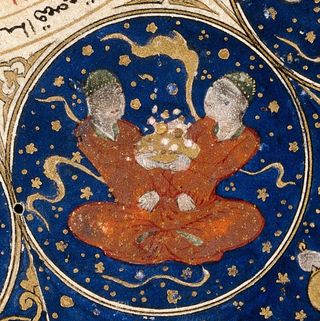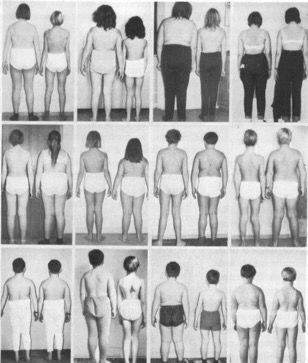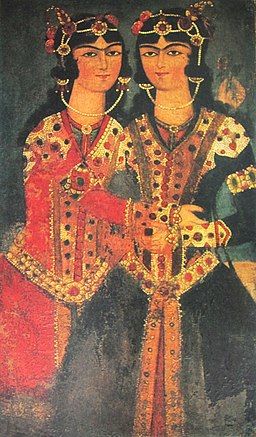Understanding Twins
Twin Studies and the "Heritage of Corpulence"
Part 1: Separating a shared environment from shared genes
Posted June 22, 2019

"What seemed like an interminable stream of identical eight-year-old male twins was pouring into the room. Twin after twin... their faces, their repeated face for there was only one between the lot of them...(p. 172) "...like maggots they had swarmed..." (p. 178) wrote Aldous Huxley in Brave New World. (1932) Here was the "principle of mass production at last applied to biology:"(p. 9) the creation of millions of identical twins, (and "not the piddling twos and threes as in the old viviparous days") (p. 8) but a "prodigious improvement on nature" (p. 8) that was intended to create social stability.

The images of Brave New World are frightening and repellent, but twins have fascinated people throughout history. There are the iconic twins of Roman mythology, Romulus and Remus, who were suckled by the she-wolf, and whose Romulus went on to found ancient Rome. And there were the noticeably different twin brothers Jacob and Esau in the Book of Genesis: Esau, "the first came out all red, all over like an hairy garment." (Genesis 25: 25) "Behold, Esau my brother is an hairy man, and I am smooth man." (Genesis 27:11) (For a comic rendition of this passage from Genesis, listen to the sermon, Take a Pew, by Alan Bennett, from Beyond the Fringe: https://www.youtube.com/watch?v=UOsYN---eGk.) And in Shakespeare's Twelfth Night, twins Viola and Sebastian resemble each other so closely, they are described as "one face, one voice, one habit and two persons. A natural perspective, that is, and is not," says the Duke. And Antonio adds, "How have you made division of yourself? An apple cleft in two is not more twin than these two creatures." (Act V, Scene 1)

Though Viola and Sebastian were difficult to distinguish from each other, they are, as male and female, fraternal, or dizygotic (DZ) twins and arise in utero from the simultaneous fertilization of two eggs by two sperm. They share, just like other siblings in a family, only 50% of their DNA. Identical or monozygotic (MZ) twins arise from the division of a single embryo and share essentially 100% of their DNA and are therefore always of the same sex. A diagnostic determination to establish zygosity is the first step in evaluation of twins and is usually made by examining hair color, eyes, shape of ears, mouth, teeth, and other physical traits, including fingerprints, as well as by sophisticated blood group antigen studies. (Börjeson, Acta Paediatrica Scandinavica, 1976)

The suggestion to use twins in research is usually attributed to Sir Francis Galton, cousin of Charles Darwin, in the late 19th century. Galton published two books, including The History of Twins and was interested in distinguishing "between the effects of tendencies received at birth and those imposed by special circumstances of life," i.e., between nature and nurture. (as quoted in Gedda, Twins in History and Science, 1961, pp. 24-25) Galton, though, did not compare fraternal and identical twins so "he cannot be considered the inventor of the twin method." (Teo and Ball, History of the Human Sciences, 2009)

Other researchers followed but there is a dark side to twin research in the early and mid-years of the 20th century, as evidenced in the work of von Verschuer, who was the mentor of Josef Mengele, infamous for his twin studies in Auschwitz during World War II. Apparently von Verschuer, who was a well-respected scientist, was a Nazi and virulent anti-Semite who used his twin studies to advance his discriminatory racial politics. (Müller-Hill, History and Philosophy of the Life Sciences, 1999) Reportedly, Mengele sent specimens of eyes and blood samples from the 200 twins on which he conducted unethical human research, to von Verschuer for analysis. Only 10% of those twins survived Mengele's human experimentation. (Müller-Hill, 1999) For a discussion of the perversion of science by von Verschuer and Mengele and the importance of a commitment to "place the best interests of the patient above those of the physician," see Coller, Journal of Clinical Investigation, 2006, who emphasizes that there are four "core values of medical humanism: preciousness or sanctity of each human life; respect for human dignity, celebration of human diversity, and a sympathetic appreciation of the complexity of the human condition." (Coller, 2006) And for a discussion of the omissions and "revisionist history" of twin research found in some textbooks, see Teo and Ball, 2009.

Early 20th century researchers, including von Verschuer, though, began to consider the role of genetics specifically in the field of obesity. Dr. George A. Bray, in his scholarly book, The Battle of the Bulge (2007), has explored the history of obesity research and reprinted original papers by Davenport (pp. 474 ff) (1923), as well as by von Verschuer (pp. 492 ff) (1927.) Davenport, who used the ratio we know as body mass index (BMI), was the first to study the relationship of genetics and environment in obesity and asked, "How far does this difference in build between slender and fleshy persons depend on constitutional factors?" (p. 474) It is from Dr. Bray (who borrowed it from mentor Edwin B. Astwood) (p. 148) that I have taken my title The Heritage of Corpulence.
Major twin studies followed, including by Swedish researcher Börjeson (1976), who analyzed the importance of heredity and environment by comparing intra-pair differences in MZ and DZ twins, and whose images of twins appear here. Further, Canadian investigator Claude Bouchard and colleagues devised their so-called the long-term "Quebec Overfeeding Study," in which they studied 12 pairs of normal weight identical male twins who remained under controlled conditions for 120 days on an inpatient unit and were fed 1000 additional calories each day for six days a week for 84 of those days. (Bouchard et al, New England Journal of Medicine, 1990; Redden and Allison, Obesity Reviews, 2004; Bouchard, American Journal of Clinical Nutrition, 2009; Bouchard et al, International Journal of Obesity, 2014; ) The mean weight gain was 8.1 kg but ranged from 4.3 to 13.3 kg. Remarkably, overfeeding led to significantly similar body weight and percentage of fat gain within each MZ twin pair, but there was three times more variance among the different pairs than from within the pairs. In other words, stringent control of the same amount of excess food intake and limited physical activity produced different responses in terms of body mass, body composition, and even regional fat distribution in genetically different twins. Bouchard emphasized that since the effect of any gene-environment interaction is usually small, researchers must try to minimize error and one way to avoid error is by actual measurement of height and weight rather than rely on self-reports that are so common in many studies. (Bouchard, Obesity, Supplement, 2008.) Further, Bouchard explained that "human variation," including a "biological determinism" in some to be more susceptible to weight gain or weight loss, is "an absolute prerequisite" in the search for any gene-environment interaction and for the eventual identification of specific genes. (Bouchard, 2008)

Throughout the years, many have created so-called twin registries of thousands of MZ and DZ twins, including those in Norway, Sweden, and Finland, and in the U.S., (e.g. National Academy of Sciences-National Research Council (NAS-NRC) Twin Registry; Minnesota Registry, and Vietnam-Era Twin Registry.) Renown obesity researcher Albert (Mickey) Stunkard, for example, used Swedish and Danish twin registries for some of his studies. (Jou, NEJM, 2014) Stunkard et al (JAMA, 1986) also used the NAS-NRC Registry to evaluate over 1900 MZ twins and over 2000 DZ twins to assess genetic contributions to height, weight, and BMI in a long-term (25 years) follow-up study, with the conclusion, "Human fatness is under strong genetic control." The researchers acknowledged, though, that estimates of heritability can be subject to criticism, with both underestimates and overestimates possibly due, for example, among other sources of bias, to errors in establishing zygosity or to even assortative mating (in which spouses tend to marry a partner of similar build.) Heymsfield and colleagues (Allison et al, Behavior Genetics, 1996) have also emphasized that "standard twin designs" for obesity do not necessarily include data such as the weights of spouses and whether assortative mating (i.e., non-random mating) may be affecting rates of heritability.
In their classic twin study, Stunkard et al (NEJM, 1990) evaluated 93 pairs of identical twins reared apart (one of the most effective means of determining the importance of shared genes from that of a shared environment); 154 pairs of identical twins reared together; 218 pairs of fraternal twins reared apart, and 208 pairs of fraternal twins reared together, all of whom were from the Swedish Registry that combined twin studies with adoption studies. Twins were evaluated in their late 50s, with 60% women. The researchers noted, though, that even when twins are reared apart, they can resemble each other if their rearing environments are similar (e.g. if twins were placed "selectively" in homes that tended to resemble those of their biological parents.) Of those twins who were separated from their biological parents, almost half of the twins were separated in the first year of life, often due to death, disease, or financial hardship in the family of origin. Stunkard et al found strong evidence for the influence of heredity on BMI, and they found that genetic influences extend across all weight categories, i.e., from those thin to those obese. They also noted that identical twins reared apart had intra-pair correlation coefficients of 0.70 for men and 0.66 for women for BMI and concluded in this study that childhood environments had little or even no influence. They do caution, though, "heritability does not imply an invariant, immutable genetic influence," but rather genetic influences under certain environmental conditions. (Stunkard et al, 1990) Along those lines, Allison, Heymsfield and colleagues (Faith et al, International Journal of Obesity, 2012) have emphasized the importance of considering the context of measurement in which environmental conditions inherent in the design of a study (e.g. reading to twins during their eating) can potentially affect results.
Over the years, Allison, Heymsfield and their colleagues have used the classic twin design to evaluate the relationship of so-called genetic architecture to the environment, including during the intra-uterine period (Allison et al, International Journal of Obesity and Related Metabolic Disorders, 1995.)They have also used this model to study body mass index and blood pressure (Allison et al, American Journal of Medical Genetics, 1995); body mass index in a pediatric twin sample (Faith et al, Pediatrics, 1999); caloric intake (Faith et al, Behavior Genetics, 1999); and self-regulatory eating (Faith et al, International Journal of Obesity, London, 2012)
Bottom line: Twin studies have evolved from the time of Sir Francis Galton, who suggested the use of twins to differentiate the effects of nature from nurture, in the late 19th century. They have been misused by researchers, such as by the Nazis during World War II. Historically, the most important early research for the field of obesity came from Drs. Claude Bouchard et al, who evaluated identical (monozygote) twins under controlled inpatient conditions in the classic Quebec overfeeding study, and from Mickey Stunkard et al, who assessed both monozygotic and dizygotic adopted twins to separate out environmental from genetic effects, in the so-called classic twin design.

Please note: This is part I of a two-part blog on the use of twins in research on obesity. Part II will explore more fully the use of the co-twin design in which one identical twin is discordant for a trait compared with the other. For special thanks to those who helped in preparation of blogs I and II, see blog II.




